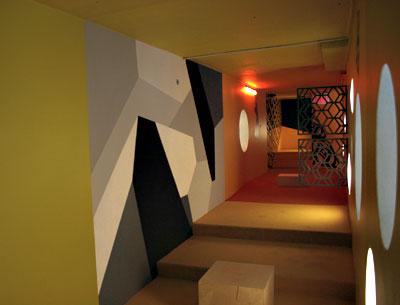Almond Zigmund: In ‘Plane Sight’

Almond Zigmund, an artist who lives in East Hampton and Brooklyn, has a new installation, “Plane Sight,” on view in what seems at first an unlikely location, the Children’s Museum of the Arts in Lower Manhattan. Founded in 1988, the museum occupied a basement space in SoHo that offered kids multiple hands-on art opportunities. Once the museum outgrew that space, it built a new, 10,000-square-foot facility that has enabled it to expand its mission.
Asked how the installation came about, Ms. Zigmund explained that last year the museum started the Bridge Project, a new program of commissioned site-specific installations by contemporary artists. “The space was literally a bridge from one part of the museum to another,” Ms. Zigmund said, “but now it’s closed off at one end. It’s next to the ballroom, which promotes physical activity, so kids tend to run up and down the corridor.” Barbara Hunt McLanahan, the museum’s executive director, had seen one of Ms. Zigmund’s permanent installations at a friend’s gallery and invited her to create something for the bridge.
Ms. Zigmund placed “punctuated marks” of sculpture and two-dimensional works on the walls and a rotating sculpture on the ceiling. “I did want something kinetic, and I wanted points of reference throughout the hallway. I like relational things; that’s what I do.” Because the walls of the hallway were painted bright yellow, green, and orange, she decided to use a black and white palette. “From a child’s perspective, I could tilt the space a little and make it look like it’s receding. At the end there’s a little cove. The whole thing looks like a ship that’s listing.”
Ms. Zigmund had what for her was the luxury of being able to spend time in the space before settling on her plan. “I packed a truck full of work and gave myself four days to figure it out.” Several elements of the original design had to be changed or removed. Two three-dimensional pieces were damaged on the first free Thursday evening, when “people always go nuts. I had told Jil Weinstock, the curator, that I didn’t care if they got damaged.” Lights installed at the intersection of a wall and the ceiling had to come down because they were too hot. The rotating sculpture was originally supposed to hang at the rear of the corridor, where the floor is closer to the ceiling, so it could be touched, but it was eventually placed out of reach.
The Bridge Project reflects the determination of Ms. McLanahan and Ms. Weinstock to bring working artists from the New York community into the museum. In addition to Ms. Zigmund’s installation, “Cabinets of Wonder,” an exhibition of work by seven contemporary artists, is also on view. Arriving just as the doors opened at 10 on a Saturday morning, one visitor watched a steady stream of parents and children filing into the museum, which is clearly fulfilling its mission: “To extend the benefits of the arts to all children and their communities and to secure the future of the arts by inspiring and championing the next generation of artists and art lovers.”
Ms. Zigmund has shows coming up in September at the Pizutti Collection in Columbus, Ohio, and in October at Arena 1, an artist-curated space at the Santa Monica airport. “Plane Sight” will remain on view through June 1.
